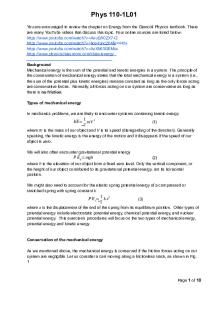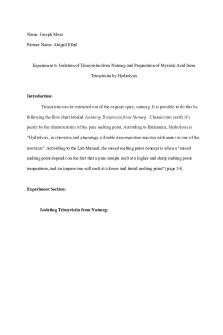EMT 1120 Mechanism lab report 5 PDF

| Title | EMT 1120 Mechanism lab report 5 |
|---|---|
| Course | Mechanisms |
| Institution | New York City College of Technology |
| Pages | 14 |
| File Size | 734.8 KB |
| File Type | |
| Total Downloads | 65 |
| Total Views | 139 |
Summary
Download EMT 1120 Mechanism lab report 5 PDF
Description
EMT 1120 D410 LAB REPORT Varying Spur Gear Train Ratios
Fahmeda Khanom & Touheda Khanom 3/18/2020
PURPOSE The main purpose of the experiment is to design a three-stage speed reducer gear train with one input and three separate output shafts. We will also calculate the train value and mechanical advantage for each output. Moreover, to measure resistive torque compared to mechanical advantage. Furthermore, to observe that the speed reducer is a torque multiplier. EQUIPMENT AND MATERIALS 1. Gear A is smaller than Gear B 2. Gear C is smaller than Gear D 3. Gear E is smaller than Gear F 4. Each Gear is a spur gear 5. Four Shafts 6. Ideal gears 7. Four legs and knurled screws 8. Gear with 30 teeth 9. Gear with 60 teeth 10.Gear with 48 teeth 11.Gear with 72 teeth 12.Gear with 36 teeth 13.Gear with 42 teeth PROCEDURE 1. In the experiment, we used six gears where A is connected to B, gear C is connected to D, and gear E is attached to F 2. We attached those gears to help rotate one with the other. One gear will drive another gear.
3. In gear A, the handwheel is attached as an input 4. However, in gear F, is considered as output and will consider output turns using gear F 5. There are three outputs in this lab and output 1 is gear C, output 2 is gear E, and Gear F is output 3 6. The output is also considered as torque 7. The ratio between the input shaft and the first output shaft is 2:1, the input shaft and the second output shaft is 3:1, and the input shaft and the third output shaft is 3:5:1 DATA Gear Combination that was selected
GEAR
TEETH
A
30
B
60
C
48
D
72
E
36
F
42
INPUT TURNS VS OUTPUT TURNS
Number of input turns
Output Shaft # 1
2
1
3 3.5 FIGURE
Output Shaft # 2
Output Shaft # 3
1 1
CALCULATIONS 1. Calculate the Three Train Values (TV, T V 2 , and T V 3 ): TV = ( # Output Turns) / (# Input Turns ) TV1=
1 2
= .5
TV2=
1 3
= .33
TV3=
1 3.5
= .28
2. Another method to find the train values using the gear teeth: TV1 = (A/B) = 30/60 = .5
TV2 = (A/B)*(C/D) = 30/60*48/72 = .33 TV3 = (A/B)*(C/D)*(E/F) = 30/60*48/72*(36/42) = .28 The train value is same and it can be found using two different methods shown above
3. Mechanical Advantage: MA1 = 1/TV1 = 2 MA2 = 1/TV2 = 3.03 MA3 = 1/TV3 = 3.57 QUESTIONS 1.
2. INPUT TURNS VS OUTPUT TURNS Number of input turns
Output Shaft # 1
2
1
Output Shaft # 2
3
Output Shaft # 3
1
3.5
3.
1
Calculate the Three Train Values (TV, T V 2 , and T V 3 ): TV = ( # Output Turns) / (# Input Turns )
4.
TV1=
1 2
= .5
TV2=
1 3
= .33
TV3=
1 3.5
= .28
Another method to find the train values using the gear teeth: TV1 = (A/B) = 30/60 = .5 TV2 = (A/B)*(C/D) = 30/60*48/72 = .33 TV3 = (A/B)*(C/D)*(E/F) = 30/60*48/72*(36/42) = .28
5.
The train value is the same and it can be found using two different methods shown above
6.
A) Mechanical Advantage: MA1 = 1/TV1 = 2
MA2 = 1/TV2 = 3.03 MA3 = 1/TV3 = 3.57 B) While slowly turning the input at a Constant Angular Velocity, successively squeeze each of the Four Shafts with my fingers I observed the resistive torque increased as we went from input shaft to output shaft. We also observed among the four shafts the shaft #3 had the greatest resistive torque. C) The values of MA agree with the observations about Resistive Torque on each output shaft. According to the calculations of MA, output #3 had the greatest mechanical advantage among the three outputs. Output # 3 is 3.57 which is greater than the other two outputs. Also, MA increases as we move from the input shaft to the last output shaft. 7. A) I observed the direction of motion of the output, Gear F is counterclockwise. B)
TV =
30 60
× 4 8/72 *36/30*30/42 = .28
C) I observed the direction of the output shaft was turning in the clockwise direction. 8. A)
30 60
× 48/72 *36/90*30/42 = .28
B) The output was turning was in the counterclockwise direction
9. A) Adding an odd and even number does not affect the train value, mechanical advantage, and torque. Odd numbers do reverse the direction but the even number does not change.
B) The size of the idler gears affects the distance between input and output. When the idler gear increases, the distance between output and input increases.
CONCLUSION In conclusion, we learned that the train value of gears can be found using the number of input and output and also by using the number of teeth of the gears. We also learned that mechanical advantage is the inverse of train value. The speed reducer gear can also be used as a torque multiplier. The torque is the twisting force that causes rotation. In the speed reducer, three outputs shafts and one input shaft was used.
INTERNET RESEARCH 1. Undercutting of Gears: The damaged of the root portion of the gear is known as the undercutting of gears
2. 20-Degree Pressure Angle: is the angle between the tooth face and the gear
wheel tangent
3. Mechanical Advantage: is the force produced by the machine to the force applied to it. Mechanical advantage is 1 divided by the train value.
4. Mechanical Advantage of Gears: is the number of output teeth gears to the number of input teeth gear 5. Torque: The twisting force that causes rotation
6. Idler Gears: is the gears that are alone in shafts excluding output and input shafts 7. Define Mathematical iteration: the repeated process where output is considered as input for the next iteration 8. Define Prime Factorization: is to multiply which prime numbers to get the original number 9. Gear Hunting Tooth: is the tooth of the two gear that Mesha and are in contact with each other during rotation
10.Golden Ratio: two quantities are in the golden ratio if their ratio is the same as the ratio of their sum to the larger of the two quantities.
11.
Fibonacci Number Sequence: is the series of numbers and the next
number is found by adding up two numbers before it. 12.Helix: is a smooth curve with numbers of tangent line with a constant angle
13.Archimedean Spiral: is the uniform movement of a straight line around one axis point.
14.Logarithmic Spiral: whose polar equation is determined by distance from the origin and is arbitrary constants.
15.Fibonacci Spiral: is also known as a golden spiral that is using quarter-circle arcs inscribed in squares.
...
Similar Free PDFs

EMT 1120 Mechanism lab report 5
- 14 Pages

EMT 1250 L4 - Lab report
- 8 Pages

LAB 5 - Lab report
- 4 Pages

Lab Report 5 - lab
- 5 Pages

Lab 5 - Lab report
- 6 Pages

Can Crusher Mechanism Report
- 14 Pages

Lab 5 - Lab experiment report
- 6 Pages

Lab 5 Lab Report- (Microbiology)
- 4 Pages

Phys lab 5 - Lab report
- 10 Pages

Experiment 5 - Lab Report 5
- 16 Pages

Post Lab Report Lab 5
- 5 Pages

Lab 5 Report
- 5 Pages

Chem lab report 5
- 7 Pages

Lab 5 Report
- 8 Pages

EX 5 lab report
- 10 Pages
Popular Institutions
- Tinajero National High School - Annex
- Politeknik Caltex Riau
- Yokohama City University
- SGT University
- University of Al-Qadisiyah
- Divine Word College of Vigan
- Techniek College Rotterdam
- Universidade de Santiago
- Universiti Teknologi MARA Cawangan Johor Kampus Pasir Gudang
- Poltekkes Kemenkes Yogyakarta
- Baguio City National High School
- Colegio san marcos
- preparatoria uno
- Centro de Bachillerato Tecnológico Industrial y de Servicios No. 107
- Dalian Maritime University
- Quang Trung Secondary School
- Colegio Tecnológico en Informática
- Corporación Regional de Educación Superior
- Grupo CEDVA
- Dar Al Uloom University
- Centro de Estudios Preuniversitarios de la Universidad Nacional de Ingeniería
- 上智大学
- Aakash International School, Nuna Majara
- San Felipe Neri Catholic School
- Kang Chiao International School - New Taipei City
- Misamis Occidental National High School
- Institución Educativa Escuela Normal Juan Ladrilleros
- Kolehiyo ng Pantukan
- Batanes State College
- Instituto Continental
- Sekolah Menengah Kejuruan Kesehatan Kaltara (Tarakan)
- Colegio de La Inmaculada Concepcion - Cebu
